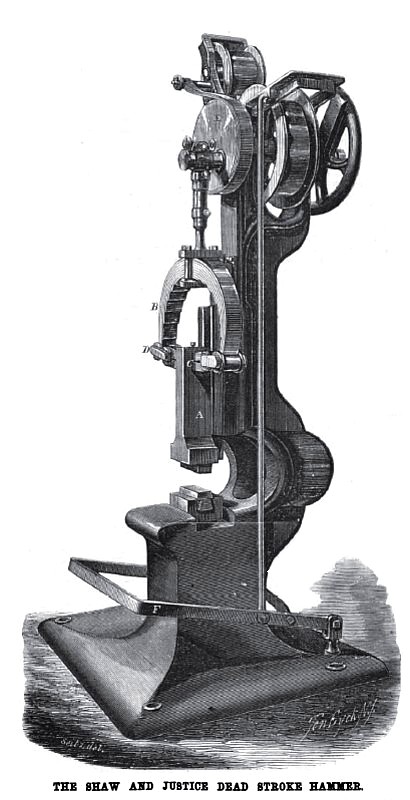|
Title: |
1868 Article-Philip S. Justice, Dead Stroke Hammer |
|
Source: |
Scientific American 26 Aug 1868 pg 129 |
|
Insert Date: |
5/2/2012 9:13:19 AM |
Improvement in Power Hammers.
We present herewith an engraving of this well-known power hammer. Since its introduction to manufacturers, nearly two years ago, it has been radically improved in its details and is considered one of the best machines for general work now in use.
The makers say: "In presenting this machine to the notice of manufacturers we claim that it has certain features, which make it indispensable for general purposes. It is a well known fact that the jar of the blow in common hammers is a source of great injury to the machine, inasmuch as the working parts are often disabled thereby; nuts are loosened, keys are slackened off, and constant supervision must be maintained in order to prevent breaking down; with all the care that can be taken such accidents frequently happen. This hammer is entirely free from dangers of this class; from the fact of the ram being supported on an elastic substance—leather—and attached to a steel spring ; through these agents the recoil is taken up, so that it is entirely distributed through them. It is particularly adapted to working thin steel, which from its incapacity to bear great heat, must be worked rapidly. In action the blow is quick and square; no double blow is given by it either on low or high heats, an advantage which will be appreciated by the trade. It occupies but little room and takes but a tithe of the power required to work the old fashioned trip hammer. It is all contained in the frame, as shown by the engraving, and is ready for use so Boon as set on its foundation. It can be run very rapidly; from 500 revolutions per minute for the smallest to 120 for the largest, the sizes at these velocities being respectively 15 pounds weight of ram, and 2,000 pounds weight of ram. It is believed that this last is the largest hammer run by a belt, in the world; the net weight of the whole machine being
20,000 lbs. These hammers have been severely tested for the last two years on all kinds of work, and testimonials innumerable, as well as the hammers themselves, can be shown. Hoe makers, shovel makers, steel workers, cutlery, hatchet, gimlet, file, horse-shoe, spring, wrench, axle, gun, and other manufacturers are
all using these hammers for various purposes and with great success.
To those who see this machine for the first time, a brief explanation of its details and action will be necessary. The chief peculiarity is suspending the ram, A, from the steel spring, B, by an ordinary leather belt, C. This belt passes through the hole in the head of the ram and is attached to the spring by jointed rollers, D, which permit the hammer, when driven up and down by the crank wheel, E, to slide up and down freely in the guide. This latter has a gib at the back for taking up the wear. The vertical movement given to the spring by the crank, compresses it so that at the return stroke the spring reacts and gives a blow of great force, which is varied in intensity by regulating the speed by the foot gear, F; one man can manage a 100 lbs. hammer with ease in this way. This is the whole and sole peculiarity of construction, and experience shows it to be one of great value. The engraving represents a 100-Ib. ram and 16inch stroke."
In conclusion, it is claimed that for a strong, durable, rapid working, and square striking hammer it is unsurpassed. One of a thousand pounds weight of ram—net weight of machine 22,000—has been for the past eighteen months at work in the Hudson River Railway Shops, foot of 30th street, New York city, and is in constant use making from an inch bolt to drawing down a seven-inch axle, and has never had a cent expended on it for repair. Parties contemplating the erection of works or extending old ones, as well as others needing machines of this kinds are invited to correspond with the manufacturer.
Sizes now made are respectively fifteen, twenty-five, fifty, one hundred, two hundred and fifty, five hundred, one thousand, and two thousand pounds weight of ram and having capacity to draw iron one inch, square, two inches, three, inches, four, six, seven, eight and ten inches square with rapidity and economy.
Further information concerning prices and where hammers can be seen will be given by addressing Philip S. Justice, 42 Cliff St., New York, or 14 North 5th St., Philadelphia, Pa.
Patents #52,894 & RE2,398 |
|
 1868 Philip S. Justice, Dead Stroke Hammer
1868 Philip S. Justice, Dead Stroke Hammer
|
|